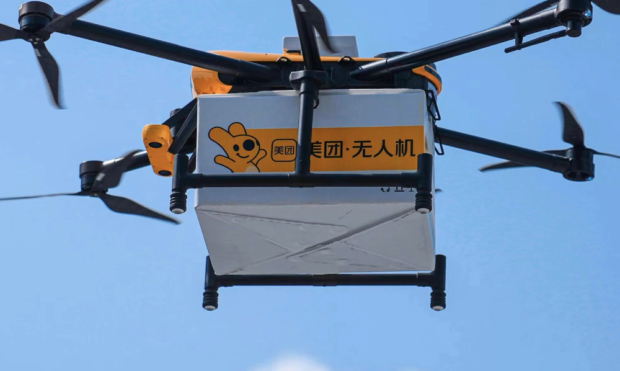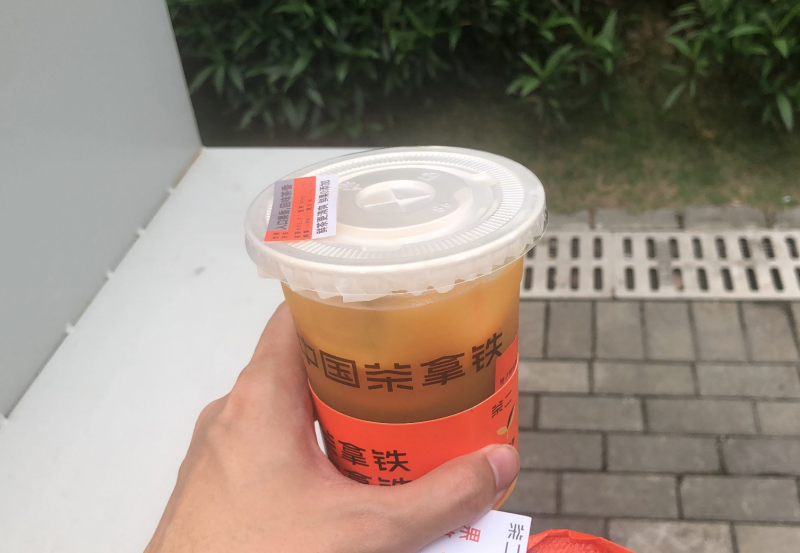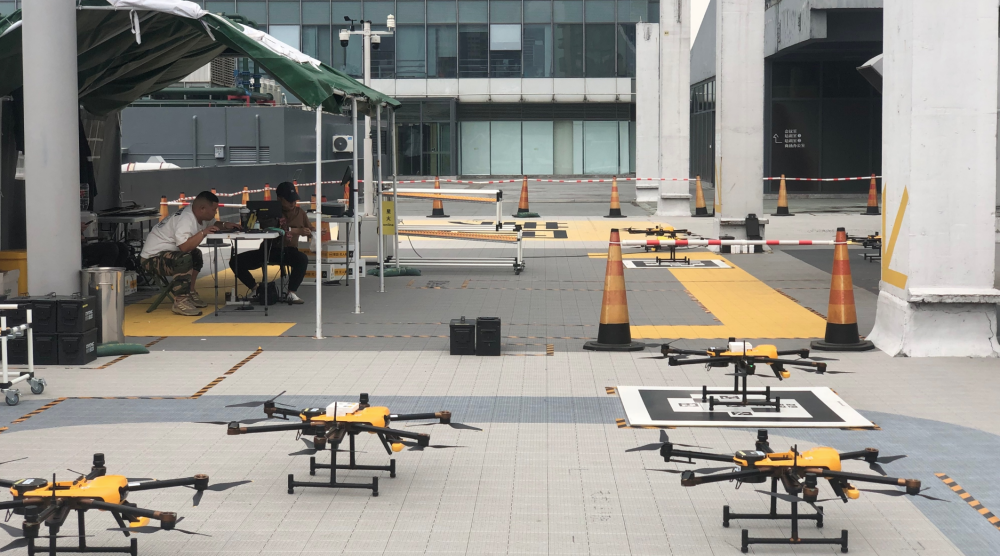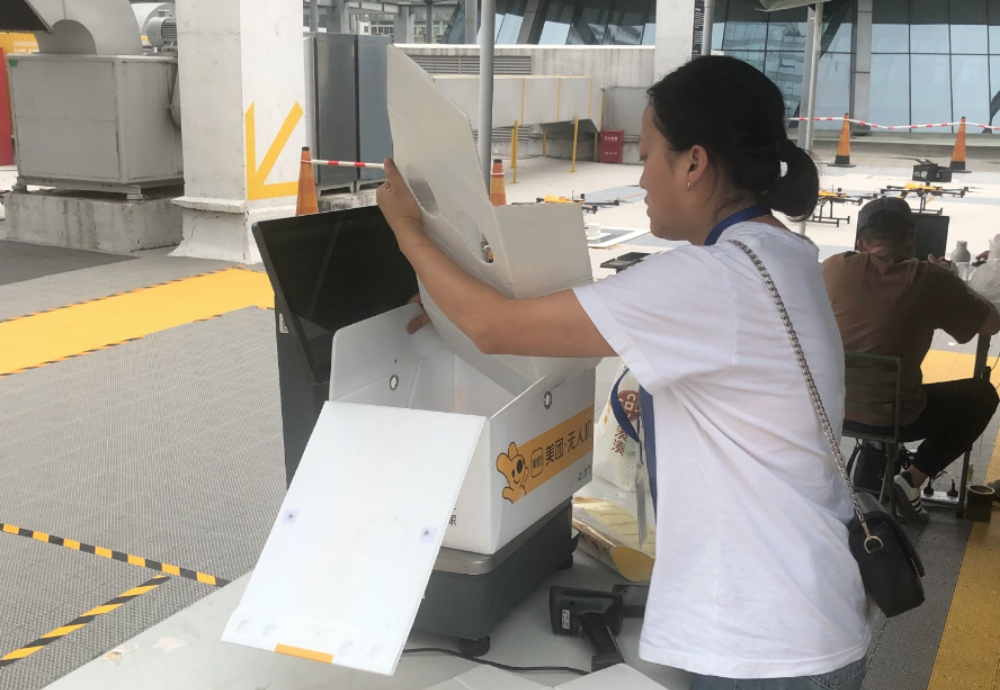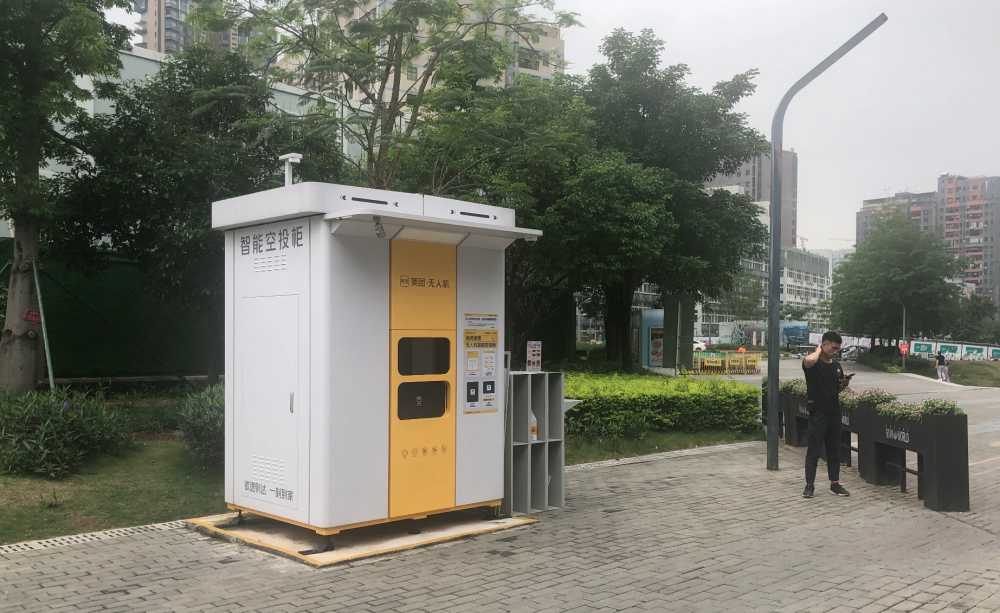While I was in China, I learned that the dominant Chinese food delivery platform, Meituan, has been flying delivery drones in the city for more than a year now, and I wanted to check it out myself. I found that the reality of drone delivery is still far from ideal, and people may be turned away by the steep learning curve.
But at the same time, it was an exciting experience—the prospect of routine drone delivery feels more realistic than it’s ever been.
Meituan currently operates more than a hundred drones from five delivery hubs (or launchpads) in the city. Together, they completed over 100,000 orders in 2022. While the platform itself can deliver basically anything, from dinner to medicine to fresh flowers to electronic devices, the drones are mostly used for food and drinks.
Why? Because Chinese people care about the temperature of their meals, Mao Yinian, head of Meituan’s drone delivery department, tells me.
“People care about it greatly—whether they can receive a hot meal or a cup of iced bubble tea in time. But when it comes to other [types of products], people don’t mind if it arrives 30 minutes faster or slower,”
he says. Since Meituan’s drone flight routes are all automated—and the drones never run into traffic—it’s easier to precisely control the time it takes for the meal to be delivered. The drones usually arrive within seconds of the estimated time.
To have a cup of bubble tea delivered exactly when you want it? As a bubble tea enthusiast, all I can say is sign me up. But when I tried it out, I found out it’s not as simple as it sounds.
The first obstacle: the drones don’t deliver to your doorstep. Instead, they deliver to one of a dozen pickup locations scattered around the city—vending-machine-size kiosks that function as both a landing pad for the drone and storage for your package if you’re late to pick it up.
Meituan is China’s most popular food delivery platform. In 2022, the company engaged some 6 million gig delivery workers to deliver billions of orders. But the company has also been developing drone delivery since 2017. And in Shenzhen, a southern city that’s home to a mature drone supply chain, Meituan has been regularly operating such delivery routes for the last year and a half.
What differentiates Meituan from these American peers is that it has chosen to offer drone delivery in what is potentially the most challenging environment: dense urban neighborhoods. It’s an approach that makes sense in China, where most people live in high-rise apartment buildings in populous cities, and many of them order food delivery on a daily basis.
To make the service work in a dense city, Meituan doesn’t have the drones deliver directly to your doorstep. Instead, the company has set up pickup kiosks close to residential or office buildings. Drones drop off deliveries at the kiosks, which can hold several packages at once. The process may be less convenient for customers, but it allows every drone to fly a predetermined route, from one launchpad to one kiosk, making the task of navigating urban areas much easier.
Here began my first attempt. After looking up all Meituan pickup locations on the map, I chose one near the subway station I was at. I ordered an iced coconut tea latte, which was specifically marked in the app as being deliverable by a drone. I paid and began waiting in excitement.
Nope. I immediately got a text telling me that “because of a system upgrade,” my order would be delivered by a human courier instead. Was it because of the bad weather? There had been a rainstorm in Shenzhen that morning, and the sky was still covered with dark clouds. But when I checked with a representative at Meituan, she said the drones were working.
It turns out, she told me, I had ordered from a restaurant in a different district, and there were no drone routes that flew from there to the kiosk I wanted to send my order to. There’s no way to know that from the app, she said.
https://youtu.be/FfyGP6LupIM
That evening, I tried it a second time. As directed, this time I chose a pickup kiosk in the same district as the restaurant. In fact, they were only a few hundred feet apart. That would surely work, right?
I ordered an avocado strawberry yogurt smoothie and again received a text immediately after the purchase was made. “Drone deliveries are not operational at this time of the day. It will be delivered by a human courier instead,” I was told. I later learned that drones only deliver until 7 p.m. every day. I was 30 minutes too late.
It wasn’t a promising start. But as it happened, I had arranged to visit one of the company’s drone launchpads the next day. So I got the chance to take an inside look at the operation.
The Rooftop Airport
Meituan launches its drones in Shenzhen from five delivery hubs. My tea actually came from one that was only a few hundred feet away, on the rooftop of a gigantic shopping mall. There, the building’s rooftop has been turned into an airport for the drones and a handful of support staff.
This launchpad services three nearby pickup kiosks. The rooftop area is divided into three zones, each with its own huge QR codes painted on the floor to mark the exact landing positions for the drones.
When I visited in April, there were about 10 drones parked on the rooftop, and two or three either taking off or landing. I had just missed the lunch peak, I was told by a Meituan employee, and the drones and humans there were mostly resting and recharging in anticipation of the dinner peak.
The workflow is a mix of human and automated labor. Once the drone delivery system gets an order (customers order specific items marked for drone delivery in the company’s app), a runner (human) goes to the restaurants, all located a few flights down in the shopping mall, to pick up the order and brings it to the launchpad. The runner places the food and drinks in a standardized cardboard box, weighs it to make sure it’s not too heavy, seals the box, and hands it off to a different worker who specializes in dealing with the drones. The second worker places the box under a drone and waits for it to lock in.
Everything after that is highly automated, says Mao Yinian, the director of drone delivery services at Meituan. The drones’ movements are controlled by a central algorithm, and the routes are predetermined.
“You can know in advance, at every precise second, where each drone will be and how fast its speed is, so the customers can expect the arrival time with a deviation of two seconds, instead of three minutes or even 10 minutes (when it comes to traditional delivery),” he tells MIT Technology Review.
The company has a centralized control room in Shenzhen, where staff can take control of a drone in an emergency. There are now more than a hundred drones that can be deployed for deliveries in the city. On average, one operator is watching 10 drones at the same time.
Not all human labor can or should be replaced by machines, Mao says. But the company has plans to automate even more of the delivery process. For example, Mao would like to see robots take over the work of loading packages onto drones and changing their batteries:
“Our ground crew may have to bend over a hundred times a day to load the package and change the batteries. Human bodies are not designed for such movements.”
“Our vision is to turn the [launchpad] into a fully automated factory assembly line,” he says. “The only work for humans is to place the nonstandardized food and drinks into a standardized packaging box, and then there’s no more work for humans.”
https://youtu.be/GCRYVUByTtM
Once I learned about the logistics involved, it was clear Meituan had made some compromises in order to make drone delivery work in densely populated areas. Arrangements like making the drones deliver to pickup kiosks instead of straight to your home may be less convenient for customers, but it also reduces the risk that drones will get trapped in difficult locations or injure people. It’s a model for other companies working on drone delivery, and you can read more about what I learned in a story on Meituan’s efforts I published this morning.
When I left the launchpad, I made one last order, from that very site to one of the three kiosks it serves. I felt confident that I’d learned everything I could about the service. Standing by the kiosk, I could even predict what direction the drone would come from, having already watched several of them complete the route from the other end.
Indeed, at exactly the time that the app predicted, the drone came and landed on the kiosk. I typed in my phone number on a screen, and after what sounded like robotic arms moving, a door lifted up, allowing me to retrieve a cardboard box. Inside was my order: an iced orange black tea, sealed in an insulating bag. My drink hadn’t spilled, and it was still cold. And I had finally accomplished my goal of getting a drone delivery in Shenzhen.
Meituan and the city of Shenzhen, where the municipal government has a strong drone manufacturing supply chain and has been particularly friendly toward the industry. On a national policy level, the central government has also permitted Shenzhen, one of the country’s designated Special Economic Zones, to have more flexibility when it comes to commercial drone legislation.
That’s why Meituan has chosen Shenzhen to carry out the majority of its drone delivery experiments so far. The company has just established a new route in Shanghai, and it has occasionally deployed drones in other cities, but Shenzhen will remain the center of its drone activity.
“The industry used to avoid urban areas because the technology was not advanced enough to guarantee it’s safe,”
Mao says. By the time he joined Meituan to head the drone delivery team in 2019, about six years after other companies had piloted rural drone delivery programs in China, he made the judgment that the technology had become safe enough to operate in cities.
There have been no reports of safety incidents with Meituan’s drones so far. Across the world, delivery drones haven’t injured any humans, but they do occasionally crash, resulting in bush fires and power outages.
Meituan has made technical adjustments to make sure its drones can safely fly in cities, like opting for wing designs that are more stable in strong winds and developing its own navigation system based on computer vision to complement weak GPS signals between buildings. In February, the company obtained a license to offer commercial drone delivery in urban areas—a stamp of approval from China’s aviation authority. But gaining the residents’ complete trust will be a longer process, Mao says:
“We need to explain to them, either through education or demonstrations where they can see the drones fly, that we can guarantee it’s safe.”
Drones vs. Humans?
Some vendors and customers have already gotten used to the Meituan drones.
I spoke to a restaurant server at the mall who said her restaurant was one of the first adopters of the drone delivery service. (She asked to be kept anonymous because she didn’t have permission to speak to the media.) The drones used to be unable to deliver during rainy days, but then the technology improved. Nowadays, the restaurant can fill dozens of orders through drone delivery every day.
One reason she likes drone delivery is that the service is more predictable, while the behavior of delivery workers can vary.
“The problem of [delivery workers] stealing food from the customer’s order is very serious,” she says. When customers complain to the restaurant that they didn’t receive the food they ordered, the restaurant bears the burden of correcting the problem.
“If it really becomes a mature technology, it will be so much more efficient,” she says. “But also, a lot of people across the country would lose their jobs.”
The same preference for drones over delivery workers can also be heard from customers. Not long after I got my iced tea from the drone, a second drone arrived at the same pickup spot. Wang, a tech worker from a nearby office who wished to be identified only by her last name, came with two friends to pick up the fruit she’d ordered. She makes such orders almost daily and finds it quite convenient.
“Compared to ordinary deliveries, it’s quicker and more sustainable, since the cardboard packages can be recycled. Plus, I don’t have to communicate with the delivery workers,”
she said. Her attitude reflects a common tension between city dwellers and gig workers, who often come from rural areas.
Mao says Meituan is not planning to replace all delivery workers; he says the main goal is for drones to complement humans. They might deliver packages to places workers can’t go, like tourist attractions that require ticketed entries, or perform urgent tasks that would be difficult for humans to pull off.
In an ideal future, drones may make up 5% or 10% of all delivery orders, Mao says. But a precise target isn’t what he’s after—he says he’s more interested in making sure that drone delivery actually adds value for customers and becomes an easy-to-use delivery method.
There is still some growing that has to happen before Meituan’s drone delivery feels seamless: there are few vendors available, and just a dozen kiosks in Shenzhen. Mao expects the service to become much more widespread in Shenzhen in three to five years.
As for the sci-fi vision of drone delivery straight to your window?
“In the longer run, I believe it will become true, but that could be 20 to 30 years from now,” Mao says. “Because it would take 20 to 30 years to update urban infrastructure, particularly when it comes to residential buildings.”
Source: MIT Technology Review

